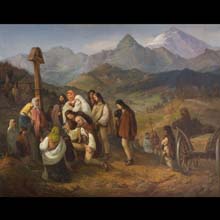
material: oil on canvas
dimensions: 63 × 80 cm
description: Similarly to other representatives of the Krakow circle, Kotsis liked painting subjects related to the Tatra mountains. Apart from pure landscapes, marked by the synthesis of realism and the fleeting mood, the artist created works in which the Tatra landscape was complemented by genre scenes from the life of highlanders. These pictures often included some critical commentaries, showing the poverty of the countryside. Kotsis painted the motif of the highland funeral at least three times. This work shows highlanders, participants in a funeral procession, who are praying at a roadside cross. The scene is set in the austere landscape of the mountains. Some stiffness and artificiality of the composition layout in the figural part, reminiscent of the so-called living pictures, which gained in popularity at that time, are contrasted with the more fluidly rendered landscape part. The detailed portrayal of regional costumes reflects an interest in ethnography and sightseeing, popular among 19th-century artists. Aleksandra Krypczyk
exposition: The Gallery of 19th Century Polish Art in Sukiennice,
The Cloth Hall, 1, Main Market Square
key: Realism, polish impressionism, beginnings of symbolism >>>
dimensions: 63 × 80 cm
description: Similarly to other representatives of the Krakow circle, Kotsis liked painting subjects related to the Tatra mountains. Apart from pure landscapes, marked by the synthesis of realism and the fleeting mood, the artist created works in which the Tatra landscape was complemented by genre scenes from the life of highlanders. These pictures often included some critical commentaries, showing the poverty of the countryside. Kotsis painted the motif of the highland funeral at least three times. This work shows highlanders, participants in a funeral procession, who are praying at a roadside cross. The scene is set in the austere landscape of the mountains. Some stiffness and artificiality of the composition layout in the figural part, reminiscent of the so-called living pictures, which gained in popularity at that time, are contrasted with the more fluidly rendered landscape part. The detailed portrayal of regional costumes reflects an interest in ethnography and sightseeing, popular among 19th-century artists. Aleksandra Krypczyk
exposition: The Gallery of 19th Century Polish Art in Sukiennice,
The Cloth Hall, 1, Main Market Square
key: Realism, polish impressionism, beginnings of symbolism >>>












